
The launching point for the development of the Ninja H2 was a strong desire to offer riders something they had never before experienced.Convinced that a truly extraordinary riding experience would not be found on a motorcycle that merely built on the performance of existingmodels, the design team committed to developing the “ultimate” motorcycle from a clean slate. The bike needed to deliver intense acceleration and an ultra-high top speed, coupled with supersport-level circuit performance. To realise this goal, help was enlisted from other companies in the Kawasaki Heavy Industries (KHI) Group, precipitating an unprecedented level of inter-company collaboration.
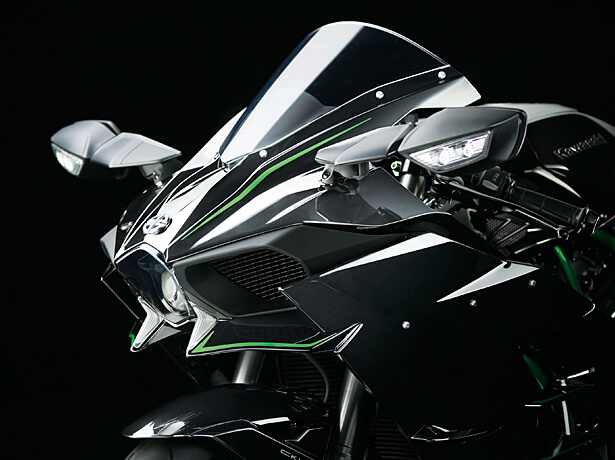
Wanting to ensure a bold design worthy of a model that carried both the “Ninja” and “H2” names, the prime styling concept chosen for the Ninja H2 was “Intense Force Design.” As a flagship for the Kawasaki brand, it required presence, and a styling that reflected its incredible performance. But the design is much more than cosmetic. While its edged styling certainly looks the part, the Ninja H2 also possesses a functional beauty: each piece of its bodywork was aerodynamically sculpted to enhance stability at high speeds; the cowling design also maximises cooling performance and heat dissipation, aiding in achieving the engine’s incredible output; and the Ram Air duct is ideally positioned to bring fresh air to the supercharger. More than any motorcycle Kawasaki has built to date, the Ninja H2 is a showcase of craftsmanship, build quality and superb fit and finish— right down to the high-tech mirrored-finish black chrome paint specially developed for this model.
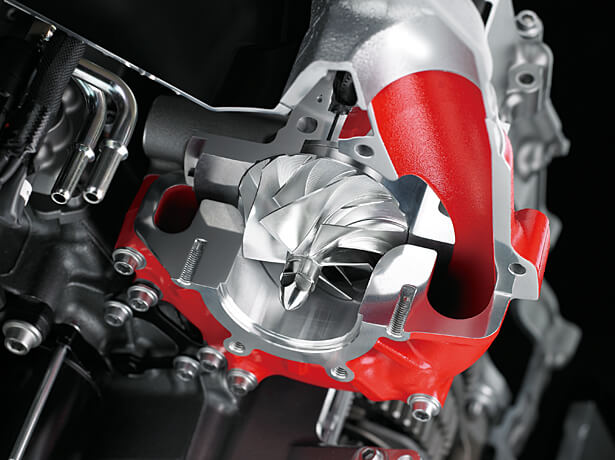
The supercharger used in the Ninja H2 was designed by Kawasaki motorcycle engine designers with assistance from other companies within the KHI Group, namely the Gas Turbine & Machinery Company, Aerospace Company, and Corporate Technology Division. Designing the supercharger in-house allowed it to be developed to perfectly match the engine characteristics of the Ninja H2. The highly efficient, motorcycle-specific supercharger was the key to achieving the maximum power and the intense acceleration that engineers wanted to offer.
200 PS @ 10,000 rpm
210 PS @ 10,000 rpm with Ram Air
140.4 N.m @ 10,000 rpm
–Centrifugal scroll – type SC
–Lightweighted alluminium material
–Impeller’s pumping capacity is over 200 litres/second
–Intake air reaching speeds of up to 100 m/s
–The supercharger is driven by a planetary gear train, which runs off the crankshaft
–Gear train increases the impeller speed to 9.2x the crank speed (1.15x step gear x 8x planetary gear). This means that at maximum engine speed (approximately 14,000 min-1), the impeller shaft is spinning at almost 130,000 min-1.
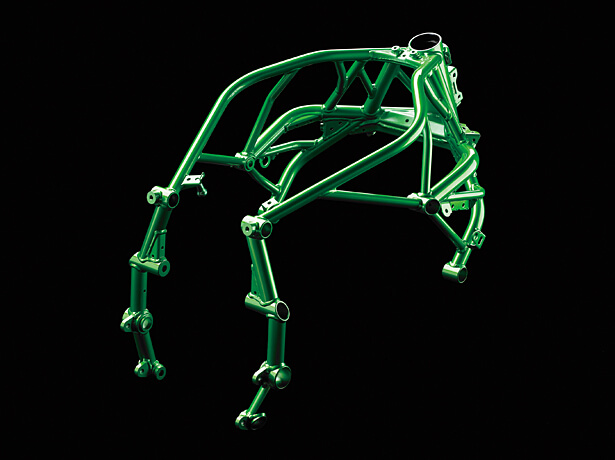
Designed for the performance parameters of the closed-course Ninja H2R and shared with the street-going Ninja H2, the objectives for the chassis were to ensure unflappable composure at ultra-high speeds, offer cornering performance to be able to enjoy riding on a circuit, and finally to have a highly accommodating character. Ordinarily, high-speed stability can easily be achieved with a long wheelbase, but a shorter wheelbase was selected to achieve the compact overall package and sharp handling that were also desired. The frame needed not only to be stiff, but also to be able to absorb external disturbances, which, when encountered while riding at high speeds, could easily unsettle the chassis. A new trellis frame provided both the strength to harness the incredible power of the supercharged engine, and the balanced flex to achieve the stability and pliability for high-speed riding.
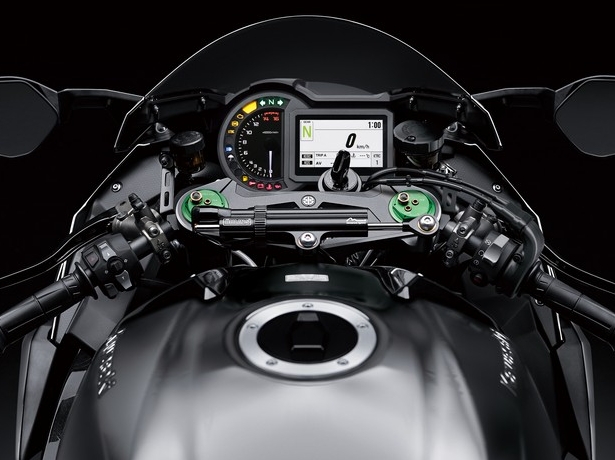
Although the Ninja H2’s high performance cannot be denied, since it was not intended to be a race bike designed to turn quick lap times as efficiently as possible, it did not need the spartan accommodation found on most purpose-built supersport models. The man-machine interface enables riders to enjoy the bike’s performance with a modicum of comfort. While the riding position, ergonomics and cockpit layout were all designed first and foremost to put the rider in the best position to control this amazing machine, the impression from the rider’s perspective is one not of austerity, but rather plush quality, high-tech control, and an impeccable fit and finish.
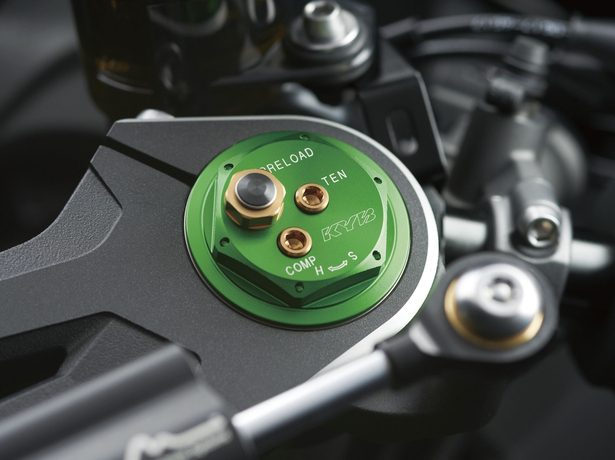
Based on the Air-Oil Separate cartridge fork developed for motocross racing, this is the industry’s first use of this high-performance racing suspension on an onroad motorcycle. Designed for low friction, the ø43 mm front fork offers superb action: smooth initial action is followed by strong damping at the end of the stroke.
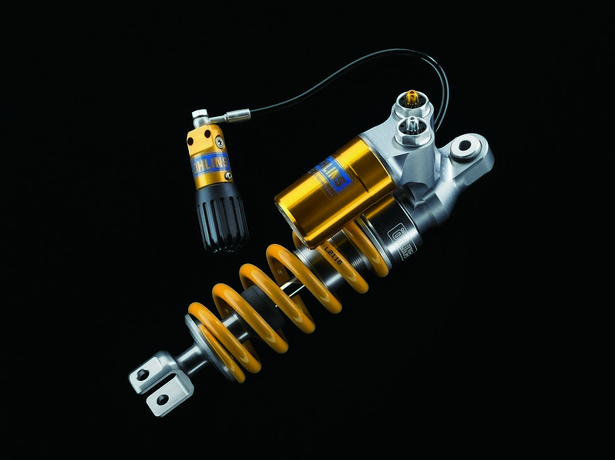
The addition of Öhlins’ highly acclaimed TTX shock offers numerous rider benefits:
>> Increased rear stability, which contributes to enhanced cornering performance.
>> Supple suspension action conveys the feeling of excellent damping and contributes to increased riding comfort and sportier handling in the hills.
>> Increased rear stability also contributes to a more planted feel at the front, contributing to increased rider confidence when riding on the circuit.
>> Superb feedback from the road.
>> On the highway the bike feels even more stable at speed, and lane changes are executed more easily.
>> Around town, the supple suspension absorbs bumps with ease, adding to ride comfort.
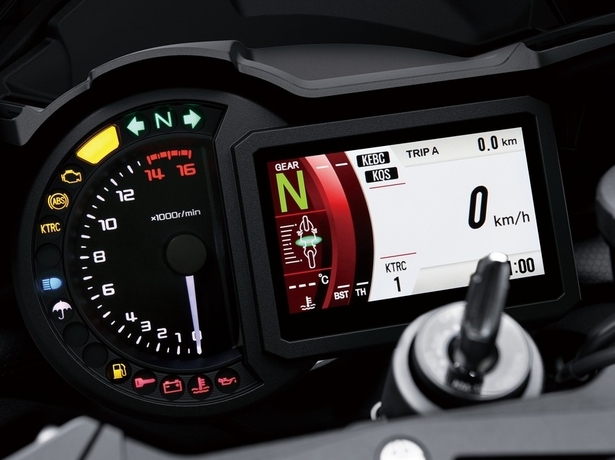
The advanced, hightech design of the instrumentation contributes to the Ninja H2’s flagship-level quality. The analogue-style tachometer is complemented by a high-grade full colour TFT LCD screen that enables information to be displayed graphically. Four selectable display modes allow riders to prioritise the information they want to see depending on the kind of riding they are doing at the time.
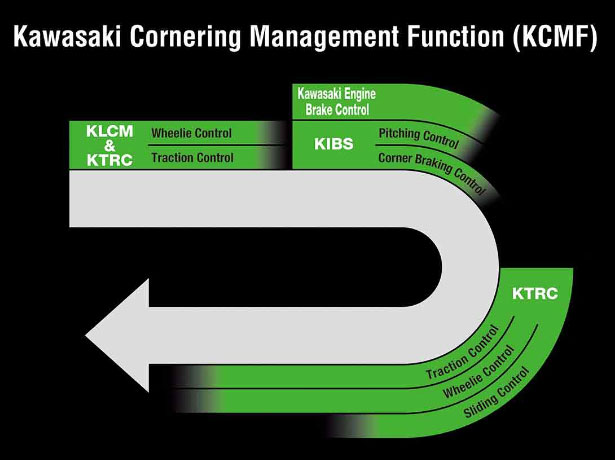
KCMF monitors engine and chassis parameters throughout the corner—from entry, through the apex, to corner exit—modulating brake force and engine power to facilitate smooth transition from acceleration to braking and back again, and to assist riders in tracing their intended line through the corner. On the Ninja H2, KCMF oversees the following systems:
- KTRC (including traction, wheelie and sliding control)
- KLCM
- KIBS (including pitching and corner braking control)
- Kawasaki Engine Brake Control
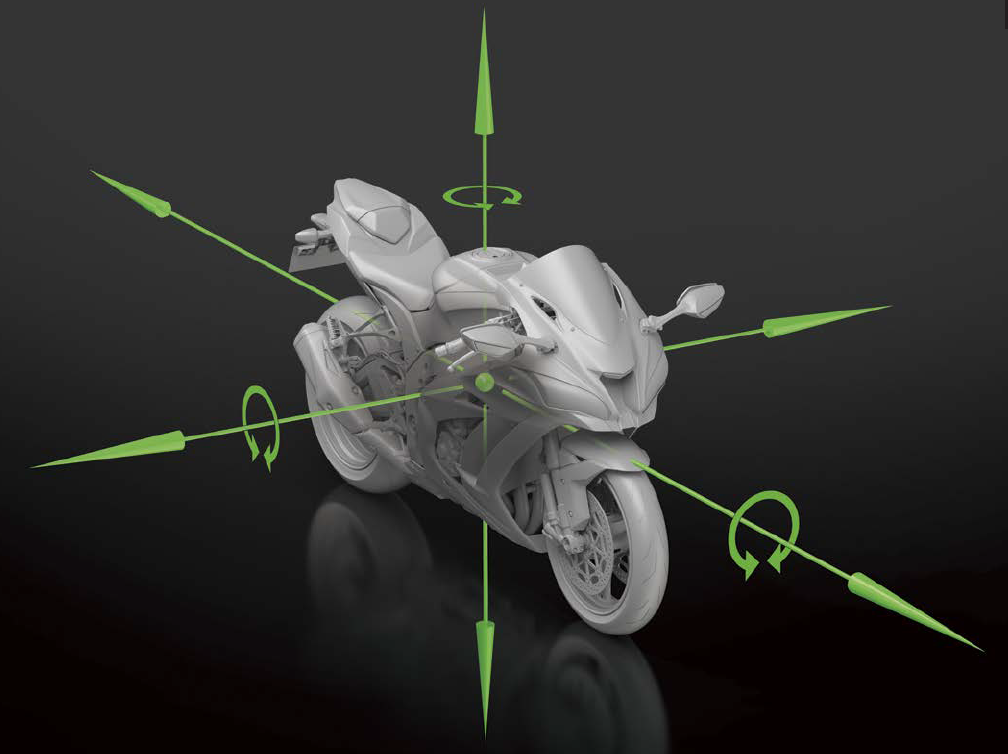
IMU enables inertia along 6 DOF (degrees of freedom) to be monitored. Acceleration along longitudinal, transverse and vertical axes, plus roll rate and pitch rate are measured. The yaw rate is alculated by the ECU using Kawasaki original software.
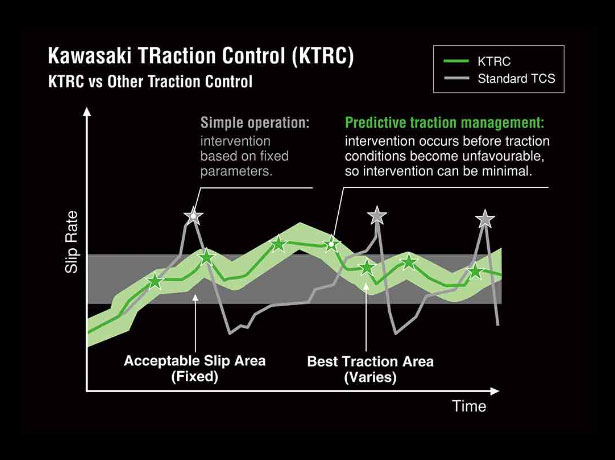
The KTRC system used on the Ninja H2 combines the best elements of Kawasaki’s earlier traction control systems. Multi-level modes offer riders numerous settings to choose from, with each mode providing a different level of intrusion to suit riding conditions and rider preference, and all modes designed to manage output when a sudden slip occurs. The system offers both enhanced sport riding performance and the peace of mind to negotiate slippery surfaces with confidence. Riders can choose from nine modes, each offering a progressively greater level of intrusion. Riders may also elect to turn the system off.
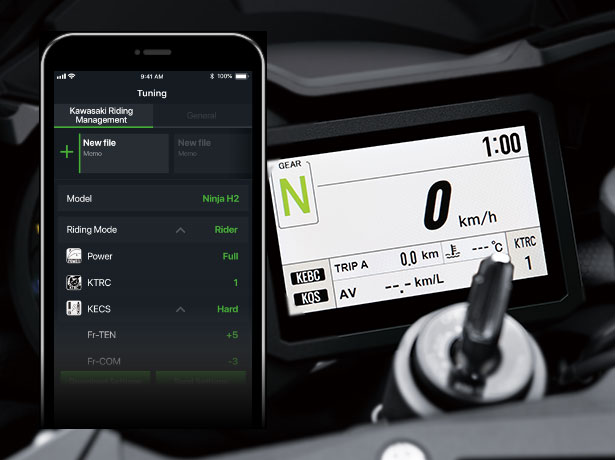
A Bluetooth chip built into the instrument panel enables riders to connect to their motorcycle wirelessly. Using the smartphone application “RIDEOLOGY THE APP,” a number of instrument functions can be accessed, contributing to an enhanced motorcycling experience.
A number of functions are available:
- Vehicle Info: information such as odometer, maintenance schedule, etc can be viewed via the smartphone.
- Riding Log: GPS route information as well as vehicle running information can be logged and viewed via the smartphone.
- Telephone notices: when a call or mail is received by the smartphone, this is indicated on the instrument display.
- Tuning – General Settings: general instrument display settings (such as preferred units, date, date format, etc) can be adjusted via the smartphone.